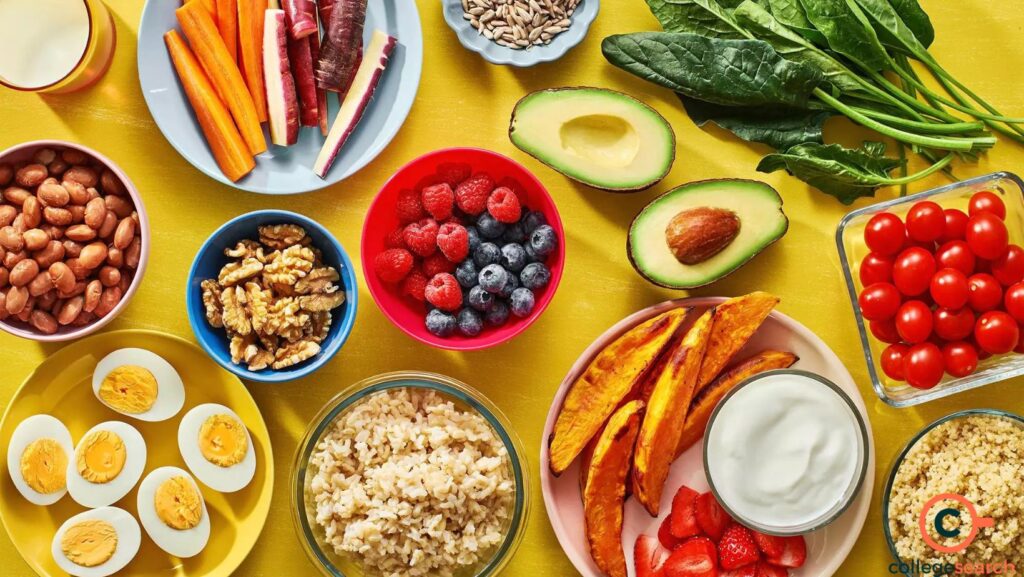
Learn how to build meals that keep you full longer by balancing proteins, healthy fats, complex carbs, and fiber. Discover how meal composition, timing, and hydration play vital roles in appetite control.
Maintaining a healthy weight, controlling hunger, and ensuring lasting energy throughout the day all start with how you build your meals. The architecture of a meal, or the way in which it is constructed in terms of its nutrient composition, plays a critical role in regulating hunger and fullness. By understanding the science of appetite control, you can design meals that keep you feeling satisfied for longer periods and support long-term health.
In this article, we’ll explore the science behind appetite, how to build meals that prevent overeating, and key components that contribute to hunger regulation. Understanding appetite architecture is the key to managing portion sizes, curbing unnecessary snacking, and ensuring that your diet is both balanced and effective.
Understanding Hunger and Fullness: The Basics
Before diving into how to build meals that keep you full, it’s important to understand the physiological processes behind hunger and satiety (fullness). Appetite is controlled by a complex interplay of hormones, the brain, and various signaling molecules. The key hormones involved in hunger and fullness include:
1.Ghrelin: Often referred to as the “hunger hormone,” ghrelin is produced in the stomach and signals to the brain when it’s time to eat. Its levels rise before meals and fall after eating.
2.Leptin: The “satiety hormone,” leptin is produced by fat cells and signals to the brain that you are full. Higher levels of leptin reduce hunger and promote a feeling of fullness.
3.Insulin: This hormone is released in response to eating carbohydrates and helps regulate blood sugar levels. It also plays a role in signaling hunger and satiety.
The combination of these hormones and the nervous system regulates your desire for food, helping to ensure your body gets the necessary nutrients it needs without overindulging.
The Role of Macronutrients in Appetite Control
When planning meals that keep you full longer, understanding the role of macronutrients—proteins, fats, and carbohydrates—is essential. Each macronutrient has a different impact on hunger and satiety, so combining them effectively can help curb cravings and ensure lasting fullness.
1. Protein: The Satiety Powerhouse

Protein is perhaps the most influential macronutrient when it comes to controlling appetite. Studies have shown that protein-rich meals lead to higher levels of satiety compared to meals that are rich in fats or carbohydrates. Protein influences hunger hormones like ghrelin (reducing its levels) and leptin (boosting its effects). It also slows down gastric emptying, meaning food stays in your stomach longer, promoting a feeling of fullness.
Some of the best protein sources include:
a) Lean meats (chicken, turkey, lean beef)
b) Fish and seafood
c) Eggs
d) Dairy products (Greek yogurt, cottage cheese)
e) Plant-based sources (tofu, tempeh, legumes)
2. Healthy Fats: Slowing Digestion for Extended Fullness
Fats are a critical part of building meals that provide lasting fullness. While fat is calorie-dense, it plays an important role in slowing down digestion, helping you feel full for a longer period. This happens because fats slow down the emptying of the stomach, which delays the sensation of hunger. Additionally, fats are integral in supporting the production of hormones like leptin, which signal to the brain that you’ve eaten enough.
Healthy fat sources include:
a) Avocados
b) Nuts and seeds
c) Olive oil and coconut oil
d) Fatty fish (salmon, mackerel, sardines)
3. Carbohydrates: Choosing Complex Carbs for Long-Lasting Energy
Carbohydrates have earned a somewhat controversial reputation in the dieting world, but when it comes to appetite control, not all carbs are created equal. Simple carbohydrates (like those in sugary snacks, white bread, and sodas) cause blood sugar levels to spike quickly, leading to a crash that can trigger hunger soon after. On the other hand, complex carbohydrates are digested more slowly, providing a steady stream of energy and promoting fullness.
Complexcarbohydrates come from whole, unprocessed foods, including:
a) Whole grains (quinoa, brown rice, oats)
b) Legumes (lentils, chickpeas, beans)
c) Starchy vegetables (sweet potatoes, squash)
d) Vegetables and fruits (broccoli, apples, berries)
The Power of Fiber: The Unsung Hero

Fiber is a type of carbohydrate that cannot be digested by the body, but it plays a critical role in hunger regulation. High-fiber foods help slow down the digestive process, which not only helps keep you feeling full longer but also helps maintain stable blood sugar levels. Additionally, fiber adds bulk to your meals, creating a sense of fullness in the stomach.
Foods that are high in fiber include:
a) Vegetables (leafy greens, carrots, Brussels sprouts)
b) Whole grains (brown rice, barley, oats)
c) Legumes (beans, lentils, peas)
d) Fruits (berries, apples with skin, pears)
Meal Composition: Balancing Macronutrients for Fullness
To build meals that are both nutritious and satisfying, it’s important to combine protein, healthy fats, complex carbohydrates, and fiber in balanced proportions. A well-well-constructed meal will keep you feeling fuller longer, helping to curb cravings and prevent overeating. Here’s how you can balance your plate for optimal fullness:
1. Protein-Rich Meals
Start your meal with a strong source of protein. A palm-sized portion of lean meat or plant-based protein (like beans or tofu) will serve as a solid foundation for satiety.
2. Add Healthy Fats
Incorporate a moderate amount of healthy fats, such as a drizzle of olive oil, a handful of nuts, or a few slices of avocado. Fat not only helps promote fullness but also adds flavor and richness to your meal.
3. Include Fiber-Rich Carbs
Choose whole grains or starchy vegetables as your carbohydrate sources. These will provide you with slow-burning energy and additional fiber to further promote fullness.
4. Fill Your Plate with Vegetables
Vegetables are low in calories but high in fiber and water content, making them an excellent choice to help fill up your plate without overeating. Leafy greens, cucumbers, and peppers are great options for adding volume without extra calories.
Timing and Meal Frequency: Eat for Lasting Fullness
In addition to the composition of your meals, when you eat and how often you eat can also play a role in controlling hunger. The timing and frequency of meals impact hormone production, digestion, and the body’s energy balance.
1. Eat Regularly, but Not Too Frequently
Skipping meals can lead to overeating later in the day. Eating three balanced meals with healthy snacks in between can help maintain stable blood sugar levels, keeping hunger at bay. Avoid excessive snacking or grazing throughout the day, as this can prevent your body from experiencing true hunger, which is necessary for proper appetite regulation.
2. Don’t Skip Breakfast
Having a protein-packed breakfast has been shown to curb hunger throughout the day. Skipping breakfast may leave you feeling hungrier later, causing you to overeat at lunch or dinner. A balanced breakfast with protein, fiber, and healthy fats is the key to starting your day off right.
3. Eat Slowly and Mindfully
Eating slowly allows your body to process the signals of fullness more effectively. It takes around 20 minutes for the brain to register that you’ve eaten enough. Taking the time to chew thoroughly and savor each bite can help prevent overeating.
Hydration and Appetite Control
Often overlooked in the discussion of appetite, hydration plays an essential role in managing hunger. Sometimes, the body mistakes thirst for hunger, leading to unnecessary snacking. Drinking enough water throughout the day can help you feel fuller and prevent overeating.
Conclusion: Building Satisfying Meals for Long-Term Health
Building meals that keep you full longer isn’t just about eating less or avoiding hunger—it’s about creating a balanced, nutrient-rich eating pattern that helps regulate appetite, supports overall health, and reduces the likelihood of overeating. By combining protein, healthy fats, fiber, and complex carbohydrates, you can create meals that fuel your body, control hunger, and promote lasting energy throughout the day.
By focusing on the architecture of your meals and paying attention to portion control, meal timing, and hydration, you can take full control of your appetite and achieve better results for weight management, energy, and overall health.

Q&A Section
Q1: Can I rely on only one macronutrient to keep me full?
A1: While protein is particularly effective at curbing hunger, a balanced approach with protein, healthy fats, and complex carbs is the best way to sustain fullness throughout the day.
Q2: Does eating more fiber help with weight loss?
A2: Yes, fiber helps control appetite by adding bulk to meals and slowing digestion, making you feel fuller for longer. This can help prevent overeating and support weight loss goals.
Q3: How often should I eat to control hunger?
A3: Eating three balanced meals with snacks in between can help keep hunger in check. Avoid skipping meals, as it can lead to overeating later in the day.
Q4: How do I avoid feeling hungry after meals?
A4: Focus on meals that include a combination of protein, fiber, healthy fats, and complex carbohydrates. These nutrients work together to keep you feeling full longer.
Q5: Can drinking water help with appetite control?
A5: Yes, staying hydrated helps prevent false hunger signals and can make you feel fuller, reducing the likelihood of overeating. Aim to drink water consistently throughout the day.